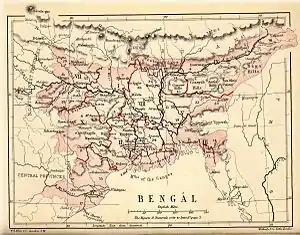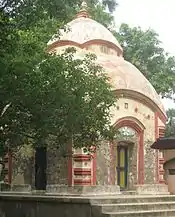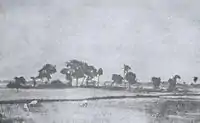Bhavashankari
Bhavashankari (Bengali: ভবশঙ্করী) was the ruler of Bhurishrestha Kingdom, who defeated the Pathan resurgence in Bengal and again established Hindu sovereignty.[1][2] Bhavashankari in her reign brought power, prosperity and grandeur to Bhurishrestha (Bhurshut).
| Bhavashankari | |
|---|---|
| Maharani of Bhurishrestha | |
| Predecessor | Rudranarayan |
| Successor | Pratapnarayan |
| Spouse | Rudranarayan |
| Father | Dinanath Chaudhuri |
Part of a series on the |
|---|
| History of Bengal |
 |
Early life
Bhavashankari came from a Brahmin family. Her father Dinanath Chaudhuri was a Nayak under the commander of the Pendo fort. Dinanath was a tall and well-built soldier, supremely skilled in the art of warfare. He himself commanded a troop of more than a thousand soldiers. He held a huge estate and encouraged his subjects to get themselves trained in warfare. Dinanath was considered among the respected nobilities of Bhurishrestha. Bhavashankari was born in Pendo, the first of two children of Dinanath. When she was young, her mother died while giving birth to her younger brother.
While her brother was brought up by a foster mother, she spent her girlhood in the company of her father. From an early age, her father began to train her in horse riding, swordsmanship and archery. She was also dressed up in military armour and accompany her father on horseback. She grew up into a brave young soldier of Bhurishrestha. Then she took lessons in war, diplomacy, politics, sociology, philosophy and theology.
Marriage

In her youth Bhavashankari used to go for hunting in the forest adjoining Damodar and Ron. Once while hunting a deer, she was attacked by wild bisons and she single handedly killed them. At that time the Rudranarayan, the king of Bhurishrestha was passing by in a sip along the Damodar towards Kasthasangara. The sight of a young woman killing a wild buffalo with a spear enthralled him. The royal marriage between Rudranarayan and Bhavashankari was fixed by royal priest Haridev Bhattacharya.
Bhavashankari had initially resolved that, she would marry him who would defeat her in swordfight.[3] However, as it was not possible for the king to engage in a mock swordfight with a commoner, she had to change her resolve. She proposed that the king shall have to sacrifice a pair of water buffaloes and a sheep in a single stroke in front of Rajballavi, the patron deity of Bhurishrestha along with her. Rajbalhat the old capital was named after the Hindu Goddess – Rajbalhavi Devi.
Reign
After marriage, Bhavashankari moved to the newly built palace on Damodar, just outside the fort of Garh Bhawanipur. As the king's consort, she began to assist in the king in his royal duties. She took special interest in the military administration of the State. She regularly paid visits to the trainee soldiers and made arrangements for upgradation and modernisation of the military infrastructures. She began to encourage each and every subject to undergo military training. Gradually she made conscription compulsory in Bhurishrestha. She built new garrison fortresses along the boundaries of Bhurishrestha and renovated the existing ones.
The kuladevata of the Bharadwaj dynasty of Bhurishrestha was Rajvallabhi, an incarnation of Chandi and her statue was made of ashtadhatu. Bhavashankari used to worship her and once made a wish that no man would ever be able to defeat her in a battle. After fasting for two days, her prayer was finally heard on the third day and her wish was granted. Jayadurga blessed her with her own strength and gave her a sword that lay at the bottom of the lake near the royal palace at Garh Bhawanipur. Full of devotion, Bhavashankari accepted the sword while taking a bath in the lake. Bhavashankari's Kuldevi Chandi is now the patron Goddess of entire Howrah district as Melai Chandi of Amta , Ma Makarchandi of Makardaha, Ma Jaya Chandi of Jaychandi Tala, a village near Domjur and Betai Chandi of Betai (Betor) in Howrah etc.
She built a temple just outside the bordering moat of the fortress at Chhaunapur, near Tarakeshwar. The temple was connected to the adjoining fort by a tunnel. Apart from serving as an escape route it served as her temporary residence when she made administrative visits to the fort. She also built a Bhavani temple in the village of Bashuri. During this period, Bhurishrestha began to prosper in agriculture and trade. Indigenous industries like handloom textiles and metal works flourished. She also built the Temples of Devi Chandi at Amta, now the patron Goddess of entire Howrah district where Amta is situated.
Soon Bhavashankari gave birth to prince Pratapnarayan. King Rudranarayan granted land and gold to the scholars and silvers, garments and food. Rudranarayan, however, died when Pratapnarayan was only five. Bhavashankari attempted to commit sati, but she was persuaded by the royal priest to act otherwise. However, she took a break from the affairs of the State to lead a life of a brahmacharini, for a period of three months.
Battle of Kastasangrah

The Kingdom of Bhurishrestha was mostly neutral during rule of the Pathan Nawabs of Gaur & Pandua. However, on account of the conversion of Kalapahad by the Karranis, Rudranarayan started making extensive war preparations in anticipation of a possible invasion. After being defeated by the Mughals, the Pathans of Bengal took refuge in Orissa. From their base in Orissa, the Pathans under the leadership of Osman Khan were planning to invade Bengal once again.[4]
Bhavashankari entrusted the affairs of the State with Durlabh Dutta, the revenue minister and Chaturbhuj Chakravarti, the commander-in-chief of the armed forces and left for the Shiva temple at Kastasangrah along with prince Pratapnarayan, accompanied with her most trusted female bodyguards. She however used to remain in clad in war attire throughout most part of the day and carried her sword and firearm with her. At the temple, the Lord was being worshipped every day; Brahmins, monks and beggars were being fed and Shiva kirtan was being held every evening. Bhavashankari used to engage herself in Shiva sadhana every night, when she meditated alone inside the temple, with only a handful of bodyguards outside.
In the meanwhile, Chaturbhuj Chakravarti entered into a secret pact with Pathan general Osman Khan, where he along with his forces would join the Pathan forces in a battle against the Mughals and upon the Pathan victory he would become the new ruler of Bhurishrestha. The Pathan forces, fed with intelligence inputs from Chaturbhuj Chakravarti, set out to capture Bhavashankari and her son alive. Osman Khan himself, along with twelve of his well-trained, experienced and most trusted soldiers infiltrated into the territory of Bhurishrestha in the guise of Hindu monks. Another contingent of 200 Pathan soldiers would follow them in disguise. However, Osman's advanced forces were spotted at Amta and as the news reached the queen, she summoned a detachment of 200 guards from the nearest garrison. At nightfall, she put on svetapatta over her armoured attire and engaged herself in worship. Her female bodyguards took guard outside the temple and the soldiers spread themselves along the jungles.
The battle ensued when one of the Pathan soldier tried to enter the temple complex by breaching the security. The female bodyguards swung into action and a swordfight ensued. Soon the royal guards joined the fight. The Pathans were miserably defeated and as they tried to escape, the royal guards chased and killed them. The second detachment of Pathan mercenaries were killed by the warrior monks of the Shaiva akhara in the nearby jungles in the wee hours. Osman fled.
Coronation and the Battle of Bashuri
Bhavashankari returned to the capital early next morning and assumed control of the affairs of the State.[5] In absence of hard evidence, she couldn't try Chaturbhuj Chakravarti, she instead demoted him in the pretext of security breach. Raja Bhupati Krishna Ray, the commander of the Pendo fort, was promoted to the post of Sarbadhinayak, the commander-in-chief of the armed forces. Apart from that she took immediate steps to strengthen the army in terms of numbers as well as infrastructure. She herself took the responsibility of their training.
At that time Bhavashankari frequently visited the Chhaunapur fort named after Chhauni or Cantonment. During her visits she used to visit the Bhavani temple at the nearby Bashuri village at least once. Her official coronation was also to be held at the temple according to Tantric rites. Golok Chattopadhayay, an eminent practitioner of Tantra was to preside over the coronation ceremony.

In the meanwhile, the Pathans regrouped and once again bought Chaturbhuj. The latter declined to directly join the Pathan forces against the Queen, but assured of sabotage. Osman Khan and Chaturbhuj conspired to capture Bhavashankari on the night of her coronation, when she would be guarded only by a few of her female bodyguards. Accordingly, Osman led a contingent of five hundred Pathan soldiers and infiltrated into Bhurishrestha territory. After travelling throughout the night, they camped in a jungle near Khanakul on the morning of the D-Day.
The Pathan army was spotted in the jungle by Kalu Chandal, a hunter, who reported it to the police at Khanakul. The officer in duty immediately dispatched a Dandanayak with the news to Garh Bhawanipur. At that time Raja Bhupati Krishna Ray was away at Pendo fort, and the acting commander Chaturbhuj dismissed the incident as a false alarm. The Dandanayak not impressed with Chaturbhuj's complacency, dispatched the news to Pendo. In the afternoon, Chaturbhuj advanced with his forces towards Khanakul. In the evening he sent a message to Osman Khan, suggesting him to launch the attack towards the end of the night. The Pathans emboldened by Chaturbhuj's support started moving towards Bashuri, crossing the Damodar near Pursurah.
After the coronation ceremony was over, she received a message from Raja Bhupati Krishna Ray, updating her on the recent developments. She immediately deployed the troops from Chhaunapur, Basdingagarh, Lashkardanga and the female battalion. An elephant brigade of 100, a cavalry of 500 and an infantry of 500 readied for the battle. The royal advisor Haridev Bhattacharya arranged irregulars from the local Bagdi and Chandal population. On the other hand, Raja Bhupati Krishna Ray led the troops from Pendo and Dogachhia to confront the renegade battalion of Chaturbhuj Chakravarti.
As the Pathan forces approached they were cornered into a battle ground surrounded with trenches on the three sides. The Pathan forces initially mistook the Bhurishrestha army as the renegade army of Chaturbhuj. In the resulting confusion, they lost the initial edge. Osman tried desperately to turn on the tables but in vain. Bhavashankari herself led the battle atop an elephant, and armed with her hand cannon Rudragnishakti she accounted for a sizeable Pathan casualty. The superior warfare skills of Bhurishrestha soldiers coupled with the strategic advantage, led them to victory. Osman Khan, wounded and defeated, fled the battle ground. After a lot of hardship he reached Orissa in the guise of a fakir.
Relationship with Mughals
Mughal emperor Akbar, who was always wary of a Pathan resurgence in Bengal, decided to strengthen the alliance with Bhurishrestha. He sent Man Singh, the then governor of Bengal to the court of Bhurishrestha as the representative of the Mughal Empire. Man Singh arrived at Garh Bhawanipur with the Mughal seal. In a special ceremony, the charter of alliance was signed between the Kingdom of Bhurishrestha and the Mughal Empire. Through this treaty, the sovereignty of Bhurishrestha was formally accepted by the Mughal empire. The treaty required the former to send a gold coin, a goat and a blanket to the latter as a token of alliance. Maharani Bhavashankari was bestowed with the title of Raybaghini and the Mughals never ever interfered with her Kingdom of Bhurshut.[6]
Later life
Two years after prince and heir apparent Pratapnarayan's marriage, the queen abdicated her throne in favour of the prince. She however, acted as the supervisor and mentor to her successor son. Few years later when Pratapnarayan began to prove his ability as a ruler, she handed over to him all the other royal duties and retired to a spiritual life. She left for Kashi and spent the rest of her life there.
Legacy
Maharani Bhavashankari became famous by her title Raibaghini, who gradually came to denote a courageous or sometimes rebellious woman and became a part of Bengali proverb. Her story of valour became a part of folklore and were immortalised by ballads and village poets. In February 2012, the West Bengal government inaugurated the annual Raybaghini Rani Bhavashankari Smriti Mela to commemorate her.[7]
References
- Ghosh, Paschimbanger Sanskriti, Volume II, pp. 224
- Ghosh, Anil Chandra. বীরত্বে বাঙালী [Heroism of the Bengalis] (in Bengali) (9th ed.). Kolkata: Presidency Library. pp. 48–50.
- Kundu, Ashok Kumar (1 October 2009). "রাজবল্লভপুরের জলঘড়ি". Kolkata: Anandabazar Patrika. Archived from the original on 22 October 2009. Retrieved 7 August 2010.
- Land and Local Kingship in Eighteenth-Century Bengal By John R. McLane
- Sarkar, Suphal (31 July 2006). "উদয়নারায়ণপুরে ধ্বংসের মুখে প্রাচীন মন্দির". Kolkata: Anandabazar Patrika. Archived from the original on 7 July 2011. Retrieved 7 August 2010.
- Sarkar, Suphal (31 December 2008). "রায়বাঘিনীর স্মৃতি পরে রয়েছে অবহেলায়". Kolkata: Anandabazar Patrika. Archived from the original on 20 July 2011. Retrieved 7 August 2010.
- Gangopadhyay, Ramaprasad (15 May 2012). "সংস্কারের অভাবে হারাচ্ছে ইতিহাস". Anandabazar Patika (in Bengali). Kolkata. Retrieved 17 October 2014.
Bibliography
- Bhattacharya, Bidhubhusan (2009). Raybaghini O Bhurishrestha Rajkahini. Kolkata: Nababharati Prakashani.
- Ray, Bharat Chandra. Raibaghini.
Bhavashankari Bharadwaj Dynasty | ||
| Regnal titles | ||
|---|---|---|
| Preceded by Rudranarayan |
Maharani of Bhurishrestha | Succeeded by Pratapnarayan |